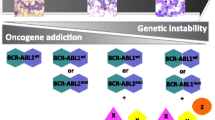Abstract
After more than a decade of treatment of chronic myeloid leukemia (CML) patients with the BCR-ABL tyrosine-kinase inhibitor imatinib, and despite the impressive results obtained with the use of this targeted therapy, the major question of how to cure CML remains unresolved. The next step for the future will be to address this key issue. CML is a model disease with a defined oncogenic driver, the BCR-ABL oncoprotein. The fact that the majority of CML patients who respond very well to BCR-ABL targeted therapy show evidence of molecular recurrence upon treatment discontinuation focuses the attention on the need for further research on the persistence of leukemic stem cells. The challenge now is to understand why, after stopping the treatment, leukemia recurs in some patients but not in others. Wining this battle is a challenge and will certainly benefit the treatment and management of other leukemias and solid tumors and will validate this new topic.
Résumé
Après plus d’une décennie du traitement de la leucémie myéloïde chronique (LMC) par les inhibiteurs de la tyrosine-kinase (ITK) BCR-ABL, dont le pionnier est l’imatinib, de nombreuses questions restent sans réponse. En effet, en dépit des résultats cliniques spectaculaires de cette thérapeutique ciblée, la question de la guérison de la LMC c’est-à-dire de l’arrêt du traitement constitue probablement une des questions les plus importantes que nous devons poser aujourd’hui. En effet, les patients excellents répondeurs identifiés par la réponse moléculaire complète (RMC) peuvent arrêter leur traitement si et seulement si elle se maintient dans le temps (> 2 ans), mais la majorité (60%) sont obligés de le reprendre en raison d’une récurrence moléculaire de la maladie, c’est-à-dire la détection de nouveau du marqueurmoléculaire BCR-ABL identifié par la technique de RT-PCR quantitative. Cependant, 40 % des patients demeurent sans traitement et sans rechutemoléculaire, malgré la persistance probable de cellules souches leucémiques. Comprendre ces deux situations est un enjeu essentiel qui motive les efforts de recherche actuels.
Similar content being viewed by others
Références
Aoki J, Ohashi K, Kobayashi T, et al. (2012) Sustained complete molecular response of chronic myeloid leukemia after discontinuation of second-generation tyrosine-kinase inhibitors. Leuk Lymphoma 53: 1412–1414
Baccarani M, Cortes J, Pane F, et al. (2009) Chronic myeloid leukemia: an update of concepts and management recommendations of European Leukemia-Net. J Clin Oncol 27: 6041–6051
Cross NC, White HE, Müller MC, et al. (2012) Standardized definitions of molecular response in chronic myeloid leukemia. Leukemia doi: 10.1038/leu.2012.104. [Epub ahead of print]
Mahon FX, Delbrel X, Cony-Makhoul P, et al. (2001) Follow-up of complete cytogenetic remission in patients with chronic myeloid leukemia after cessation of interferon alfa. J Clin Oncol 20: 214–220
Mahon FX, Rea D, Guilhot J, et al. (2010) Discontinuation of imatinib in patients with chronic myeloid leukaemia who have maintained complete molecular remission for at least 2 years: the prospective, multicentre, Stop IMatinib (STIM) trial. Lancet Oncol 11: 1029–1035
Mahon FX, Rea D, Guilhot J, et al. (2011) Discontinuation of imatinib in patients with chronic myeloid leukemia who have maintained complete molecular response: update results of the STIM study. Blood (ASH Annual Meeting Abstracts); Abstract 603
Rea D, Raffoux E, Cayuela JM, et al. (2009) Sustained major molecular response in the absence of any antileukaemic therapy after dasatinib treatment and autologous peripheral blood stem cell transplantation in a patient with imatinib-resistant myeloblastic-phase chronic myeloid leukaemia. Leukemia 23: 1158–1159
Rea D, Rousselot P, Guilhot J, et al. (2012) Curing chronic myeloid leukemia. Curr Hematol Malig Rep 7: 103–108
Rea D, Rousselot P, Nicolini FE, et al. (2011) Discontinuation of dasatinib or nilotinib in chronic myeloid leukemia patients with stable undetectable Bcr-Abl transcripts: results from the French CML group (FILMC). Blood (ASH Annual Meeting Abstracts) 118: 604
Ross DM, Bartley PA, Goyne J, et al. (2011) Durable complete molecular remission of chronic myeloid leukemia following dasatinib cessation, despite adverse disease features. Haematologica 96: 1720–1722
Ross DM, Branford S, Seymour JF, et al. (2010) Patients with chronic myeloid leukemia who maintain a complete molecular response after stopping imatinib treatment have evidence of persistent leukemia by DNA PCR. Leukemia 24: 1719–1724
Rousselot P, Huguet F, Rea D, et al. (2007) Imatinib mesylate discontinuation in patients with chronic myelogenous leukemia in complete molecular remission for more than 2 years. Blood 109: 58–60
Takahashi N, Kyo T, Maeda Y, et al. (2012) Discontinuation of imatinib in Japanese patients with chronic myeloid leukemia. Haematologica 97: 903–906
Yhim HY, Lee NR, Song EK, et al. (2012) Imatinib mesylate discontinuation in patients with chronic myeloid leukemia who have received front-line imatinib mesylate therapy and achieved complete molecular response. Leuk Res 36: 689–693
Author information
Authors and Affiliations
Corresponding authors
About this article
Cite this article
Réa, D., Mahon, F.X. Arrêt du traitement par inhibiteurs de tyrosine-kinase. Oncologie 14, 606–608 (2012). https://doi.org/10.1007/s10269-012-2223-4
Received:
Accepted:
Published:
Issue Date:
DOI: https://doi.org/10.1007/s10269-012-2223-4




